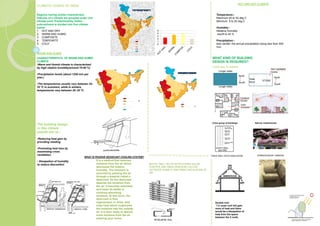Climatic zones of india
- 1. CLIMATIC ZONES OF INDIA Regions having similar characteristic features of a climate are grouped under one climate zone. Predominantly, Indian subcontinent is divided into five climate zones- 1. HOT AND DRY. 2. WARM AND HUMID. 3. COMPOSITE 4. TEMPEARTE 5. COLD CHARACTERISTICS OF WARM AND HUMID CLIMATE âĒWarm and Humid climate is characterized by high relative humidity(around 70-90 %) âĒPrecipitation levels (about 1200 mm per year.) âĒThe temperatures usually vary between 25â 35 šC in summers; while in winters, temperatures vary between 20â30 šC. WAR M HUMI D CLIM ATE The building design in this climate should aim at â âĒReducing heat gain by providing shading âĒPromoting heat loss by maximizing cross ventilation. âĒ Dissipation of humidity to reduce discomfort. WHAT KIND OF BUILDING DESIGN IS REQUIRED? PASSIVE DESSICANT COOLING SYSTEM WHAT IS PASSIVE DESSICANT COOLING SYSTEM? It is a method that removes moisture from the air which decreases the relative humidity. The moisture is removed by passing the air through a material called a desiccant. As the desiccant absorbs the moisture from the air, it becomes saturated and loses its ability to continue absorbing moisture. At this point, the desiccant is then regenerated, or dried, with solar heat which evaporates the moisture into the outside air. It is then ready to absorb more moisture from the air entering your home. BAFFEL WALL HELPS IN PROVIDING SOLAR CONTROL AND SIMULTANEOUSLY ALLOW OUTDOOR VISIBILTY AND FREE CIRCULATION OF AIR 0 1 2 3 4 5 HOT AND DRY CLIMATE WARM AND HUMID Temperature:- Maximum 40 to 45 deg C Minimum 5 to 25 deg C Humidity:- Relative Humidity low25 to 40 % Precipitation:- less rainfall- the annual precipitation being less than 500 mm. North South Toilet Store North South Longer sides Longer sides Non habitable rooms STORE FORM AND PLANNING Open courtyard Clustered Houses Close group of buildings Narrow roads/streets THICK WALL WITH INSULATION TERRACE/ROOF GARDEN Double roof. The outer roof will gain more of heat and there would be a dissipation of heat from the space between the 2 roofs.
